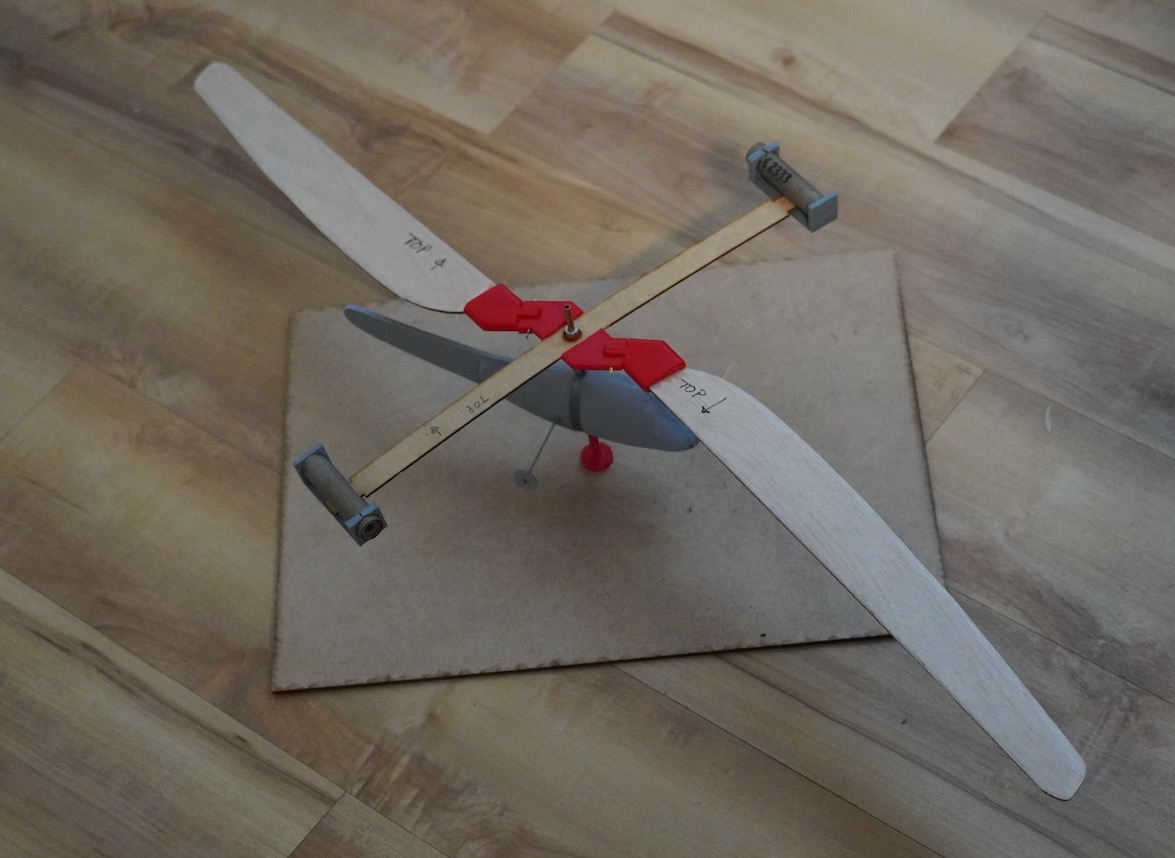I've now managed several flights with the Tendera powered Jeticopter and although there's still some work to do I am making progress. Additionally, I'm finding out a few things about rotor lifted craft.
Having decided, after the earlier attempts that the model needed a considerable weight loss program, I created a new fuselage and landing gear. The new fuselage is considerably smaller and lighter than previously. Now, I haven't seen any figures for how much the various designs of Jeticopter/delta hinged rotorcraft are expected to weigh. With kit based designs, the target weight and the precise spec. of all parts is not always stated. One is expected to use the bits provided in the kit and what you get is what you get!
Anyway, with a new fuselage, 3D printed in lightweight PLA - based roughly on the Jeticopter outline and 'lofted' from the fuselage former outlines shown on the plan, I came up with a new all up weight (with used motors installed) of 102gms.
I decided to lock the rotor angle, for experimental purposes, to a positive AoA. From my earlier trials I'd thought it possible that, perhaps either the rotor was not spinning fast enough or the rotor blade mass was insufficient to ensure a positive AoA under power. - The Jeticopter hinged rotor works a little like a centrifugal governor. When spinning fast under power the rotor disc should be flat and the 'delta hinge' induces a positive AoA. At the end of the power run, as the rotor slows down, it should cone up and when it does the delta hinge induces a negative AoA. This to permit a 'autorotation' style - gentle - descent.
Anyway, with a fixed positive AoA, if the rotor was spinning fast enough and the weight low enough we should at least see an ascent ibut not a autorotation descent.
I decided to hand launch - to eliminate the possibility of the Jeticopter hanging up on the launch rod. So with two fresh L3s installed, and wearing my safety goggles, I lit the fuses (first one at the end of the fuse, second one half way down) and was pleased to see both motors striking up pretty much simultaneously.
So, holding the model by the lower part of the fuselage I raised it up and released it. There was pretty much no wind and at first the model, clearly ascending, stayed pretty much directly overhead. This made it hard to judge the height and it was only as the motor run came to an end that I was able to see that the model was maybe 50ft in the air.
Then, as the rotor slowed down the model descended until, with the rotor pretty much stopped, it flipped inverted. Now, with a negative AoA the rotor started to rotate again (!!!) and so the model reached the ground relatively slowly and was undamaged.
The interesting point here is how stable the spinning rotor is in respect to the horizon. I'd noticed earlier that regardles of launch angles and various ups and downs the rotor plane stayed horizontal. I'd put this down to a kind of pendelum stability but clearly with the inverted autorotation something else is going on. Now there isn't an abundance of technical literature on free flight helicopters (Jetex powered or otherwise) so for me the question of uncontrolled spinning rotor stability remains a mystery!
And the next test flight was equally interesting. On this one I followed the same hand launch procedure and as I was launching one of the rotor blades came adrift. Perhaps it had clipped the fuselage or my shirt sleeve. I had intended to try and photograph this attempt but at this I didn't even bother to reach for my phone.
Neverthless the model gained height and likely got almost as high as on the previous flight. This time, as the remaining single spinning roto blade slowed, there was no sign of an autorotation (inverted or otherwise) and the model simply plumeted. Much to the amusment of several bystanders „Das ist ein gutes Spielzeug.“
„So soll es nicht funktionieren!“
What can we deduce from this? Perhaps that the current rotor size is actually too great? We'd loss more weight and spin faster with smaller blades.
There's also the matter of the freely moving hinged rotors. Are we achieving a positive AoA under power? I've thought about a way of establishing this without firing off loads of motors but I haven't had chance to try this yet.
And there's still more scope in the design for weight reduction.
More on this next time.
This version weighs in at 92gms - previously 124gms.


